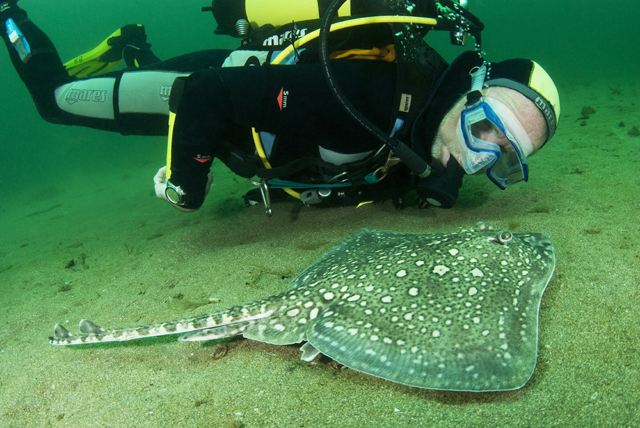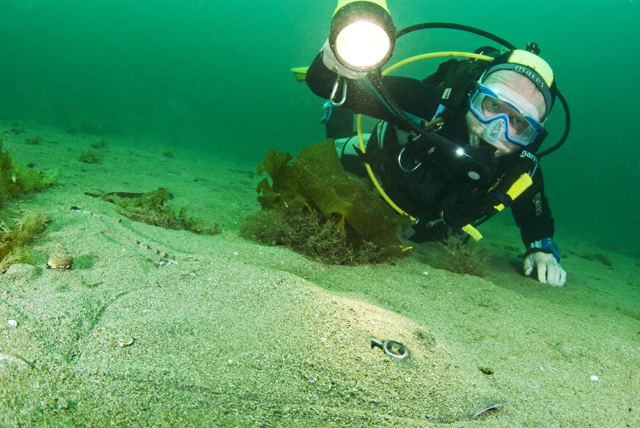Marine Life & Conservation
Have A Ray Day
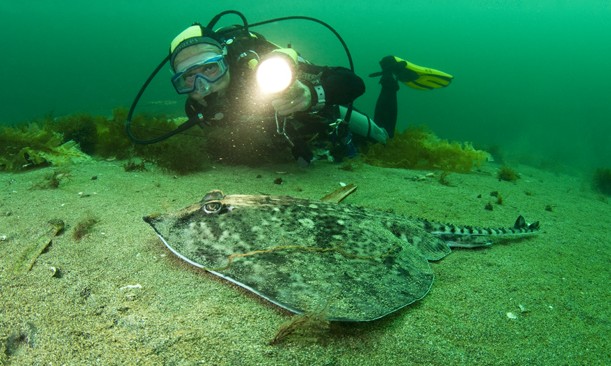
Mike Anselmi, the owner of Porthkerris Dive Centre in Cornwall, said that the Helford River Estuary is one of the most popular dive sites in the area. The shallow seabed attracts all sorts of interesting marine life including Sea Hares, Cuttlefish, Clams, Scallops, Hermits and Blonde Rays. May through to August is peak season for Thornback Ray (Raja clavata) sightings. Mike said that the Rays congregated in larger numbers around mid-August. During this time it’s not unusual to see at least 5 or 6 different individuals on a single 1 hour long dive. The Rays stick together in loose packs, so when one is sighted there are usually others somewhere close by.
This is a unique underwater experience and gives divers and photographers the perfect opportunity to get up close and personal with these creatures. It’s even possible to swim side by side as they effortlessly ‘fly’ across the seabed. Thornbacks shouldn’t be confused with their close relatives, Sting Rays. They are totally non-aggressive and pose no threat to divers. There are no lethal looking barbs protruding from the tail. Instead they have 30-50 spines along the tail and up the back which could potentially give someone a graze but only if the Ray is grabbed or picked up. The mouth is located on the white coloured underside. This has rows of very small teeth which make perfect tools for crunching on Crabs, Prawns and Flatfish – not divers.
The Charter Boat
Mike has been running the family business for more than 22 years. He owns 2 hard boats and a twin engined RIB. We went out on Mike’s flagship, the 14 metre long Celtic Cat. Getting onto the boat is quite a novel experience. There is no jetty, so divers have to walk along a high rise gangplank which is then pushed into the sea by a Tractor. Mike’s other hard boat, the smaller 8 metre long Celtic Kitten, has a bow ramp so it can come right up to the beach. Celtic Cat has plenty of room onboard for kitting up and gear stowage. The boat also has a big enclosed cabin area and an inner sanctum where I could get hot drinks. Mike has fitted a double diver lift on the stern which is controlled by CCTV linked to the high rise Bridge. Mike normally offers the Thornback Ray dive as and when he’s asked. He said that the Rays come closer inshore during calm weather; they don’t like choppy seas.
Arrival at the site
Porthkerris Dive Centre is located way down on the South West Coast of Cornwall near the Lizard. RNAS Culdrose is a good landmark to aim for and then follow the signs to St Keverne. The last few miles can be quite confusing (I took the wrong turning, duh!) but there’s still a mobile signal for any ‘help, I’m lost’ SOS calls to the dive centre. When I started seeing the Basking Shark (this is the other big attraction) signs I knew I was on the right track. The narrow hedge-lined lanes eventually open out onto a very picturesque little bay. The new dive centre building is located right next to the pebble beach. On-site facilities include a dive shop, 2 camp sites, toilets, cafe, car park, gas fills and plenty of shore diving possibilities. There are even a number of Pubs close by. The local Seal sanctuary located at Gweek is also worth a visit during off gassing periods.
Pre-dive briefing
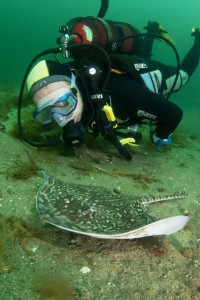
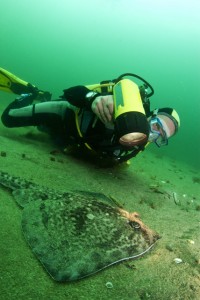 The Helford River is about 20 minute’s boat ride from Porthkerris Dive Centre. At high water it’s around 12 metres deep at the river mouth and 8 metres further up the estuary by the boat moorings. The seabed is made up of sand and shingle in the central channel. Nearer the edges and further up the estuary this changes to a maerl-like composition interspersed with patches of weed (perfect for Scallops).
The Helford River is about 20 minute’s boat ride from Porthkerris Dive Centre. At high water it’s around 12 metres deep at the river mouth and 8 metres further up the estuary by the boat moorings. The seabed is made up of sand and shingle in the central channel. Nearer the edges and further up the estuary this changes to a maerl-like composition interspersed with patches of weed (perfect for Scallops).
There can be strong currents, so it’s best to dive a few hours before high water on the flood tide when things are calming down. The visibility will be better and there is more chance of seeing Thornback Rays. Keep a close eye on air supplies, as chasing after Rays can be quite a tank-draining exercise. All divers should carry a delayed SMB. Mike asks that they are deployed at the end of the dive before commencing any safety stops. This is a busy waterway so be extra vigilant on ascents. Propeller haircuts are not advisable.
Mike dropped us in the middle of the channel right by the River mouth. The tide was still flooding which meant that the current would take us inside the channel rather than out to sea. We would also have ‘cleaner’ water for my photographs. We made a free descent without reference to the seabed. The Rays are not in any particular area so there is no set direction to take, it’s basically pot luck. We drifted along with the current scanning the seabed for any Ray like shapes.
The Dive
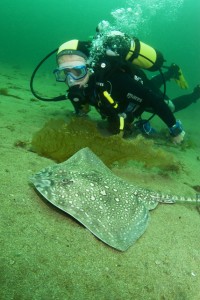 Creeping up on Thornback Rays turned out to be easier than I expected. I had brought along Brian Hayes, a diving friend of many years, to act as ‘model’ and Ray spotter. We found our first Ray in the first 2-3 minutes of our dive. I could make out the diamond shaped outline hidden under the sand. A pair of eye stalks and a sharp pointy nose were the only parts visible. I guess this was in readiness to strike at any prey that unwittingly wandered into the kill zone.
Creeping up on Thornback Rays turned out to be easier than I expected. I had brought along Brian Hayes, a diving friend of many years, to act as ‘model’ and Ray spotter. We found our first Ray in the first 2-3 minutes of our dive. I could make out the diamond shaped outline hidden under the sand. A pair of eye stalks and a sharp pointy nose were the only parts visible. I guess this was in readiness to strike at any prey that unwittingly wandered into the kill zone.
Working as a team we managed to get within touching distance of around 5 or 6 different Rays on each dive. The Rays seemed to react differently depending on the tide conditions. While the tide was still flooding they were more active and on the move. Mike thinks this is when they are feeding. On 3 occasions we had to swim like lunatics just to keep up. When there was very little tide we found 2 or 3 different Rays buried in the sand and they were very easy to approach – in fact, I could have touched them with my camera dome and they still wouldn’t have budged. I even got Brian to do a ‘Steve Irwin’ manoeuvre over the top of a Ray for a close-up head shot and there was still no reaction. Maybe the Ray thought that its camouflage was so good we couldn’t see it.
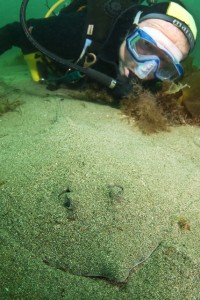 As the tide turned there seemed to be less Rays about and they were moving much more slowly. We had also moved up the estuary nearer to the boat moorings. The seabed composition had changed and there were far more Sea Hares around. We swam along with one particular Ray for a good 5 minutes and then bumped into a very photogenic Cuttlefish. None of the Rays shot off in an erratic manner or seemed distressed by our presence. Considering they were being sandwiched by 2 divers this was quite surprising.
As the tide turned there seemed to be less Rays about and they were moving much more slowly. We had also moved up the estuary nearer to the boat moorings. The seabed composition had changed and there were far more Sea Hares around. We swam along with one particular Ray for a good 5 minutes and then bumped into a very photogenic Cuttlefish. None of the Rays shot off in an erratic manner or seemed distressed by our presence. Considering they were being sandwiched by 2 divers this was quite surprising.
The Thornbacks we encountered varied in size from small 20cm wingspans to much bigger 50cm plus specimens. The colour schemes were usually grey or brown with a kaleidoscope pattern of spots and splodges on the topside. Most had 2 claspers dangling from the tail area meaning they were males. We only encountered one small female. Average recorded sizes are around 60 cm and weigh in at 3 or 4kg’s. They can grow to more than a metre in length and weigh over 15kg’s.
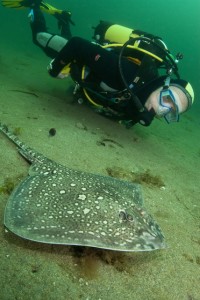 This has to be one of the best marine life dives in the UK and it’s at a shallow depth where every level of diver can safely join in the fun. Our close encounters were totally natural. There was no provocation or feeding enticements going on in the background. They say a picture paints a thousand words so hopefully my photographs show just how close we managed to get. With rather more luck than judgement we had chosen a perfect day for weather. There was plenty of sunlight and very little wave action to worry about. Underwater visibility was around 8 metres throughout and the current took away any kicked up silt during our power finning spurts. For once I actually had to admit this was pretty good going for UK conditions. The toughest part of the day was keeping my model focused on the job in-hand. Brian was getting more and more distracted by the number of decent sized Scallops scattered over the seabed. He even had his goody bag at the ready!
This has to be one of the best marine life dives in the UK and it’s at a shallow depth where every level of diver can safely join in the fun. Our close encounters were totally natural. There was no provocation or feeding enticements going on in the background. They say a picture paints a thousand words so hopefully my photographs show just how close we managed to get. With rather more luck than judgement we had chosen a perfect day for weather. There was plenty of sunlight and very little wave action to worry about. Underwater visibility was around 8 metres throughout and the current took away any kicked up silt during our power finning spurts. For once I actually had to admit this was pretty good going for UK conditions. The toughest part of the day was keeping my model focused on the job in-hand. Brian was getting more and more distracted by the number of decent sized Scallops scattered over the seabed. He even had his goody bag at the ready!
Marine Life & Conservation
Paul Watson Released as Denmark Blocks Japan’s Extradition Bid

Renowned anti-whaling activist Paul Watson has been released from custody in Greenland after spending five months in detention. Denmark’s Justice Ministry rejected Japan’s request for his extradition, citing insufficient guarantees that his time already served in custody would be credited against any potential sentence.
The 74-year-old Canadian-American was arrested on July 21 in Nuuk, Greenland’s capital, when his ship docked to refuel. His arrest was based on a 2012 Japanese warrant related to a 2010 encounter in Antarctic waters. Japan alleged Watson obstructed operations and caused damage to a whaling research ship during efforts to disrupt illegal whaling. Watson has consistently denied these claims, maintaining his commitment to marine conservation.
Denmark, which oversees extradition matters for Greenland, concluded that while the legal conditions for extradition were met, the lack of assurances from Japan regarding time-served credit made extradition untenable.
In a video shared by his foundation, Watson expressed gratitude and relief, saying, “After five months, it’s good to be out… and good to know they’re not sending me to Japan.” He added that the most difficult part of his time in custody was being separated from his two young sons.
Watson is a pioneering figure in marine conservation, known for founding the Captain Paul Watson Foundation in 2022 after decades of activism with the Sea Shepherd Conservation Society. His bold efforts to defend marine life have earned him widespread support, including from celebrities and conservationists. His work has also been featured in the acclaimed reality TV series Whale Wars.
Watson’s lawyer, Jonas Christoffersen, praised the decision, stating, “We are happy and relieved that Paul Watson is now free.” He added that Watson is eager to reunite with his family and continue his vital work.
The arrest occurred while Watson’s vessel, the M/Y John Paul DeJoria, was en route to the North Pacific with a team of 26 volunteers to intercept a Japanese whaling ship. His foundation described the arrest as politically motivated and emphasized that Watson’s actions were focused on ending illegal whaling practices.
Japan resumed commercial whaling in 2019 after leaving the International Whaling Commission, asserting that whale meat is a cultural tradition. Conservationists, however, continue to challenge these practices, highlighting their impact on marine ecosystems.
Despite the challenges, Watson remains steadfast in his mission to protect marine life and bring attention to whaling practices. His dedication to ocean conservation has made him a globally respected advocate for the environment.
Marine Life & Conservation
12 Days of Zero-Waste Fish-mas

This holiday period, the Marine Conservation Society, the UK’s leading ocean membership charity, invites you to make some simple changes to eating fish this Christmas to help our seas.
Dr Kenneth Bodles, Head of Fisheries and Aquaculture at the Marine Conservation Society, said, “During the festive season, our consumption increases, but so does waste. Sustainability isn’t just about where food comes from – it’s also about how you use it. By reducing waste and making the most out of your seafood, you’re not only taking steps to be more ocean-friendly, but can also help to cut costs during what is often one of the most expensive times of the year”.
The Marine Conservation Society has compiled twelve tips on how to consume seafood sustainably with zero-waste this Christmas:
Buy whole fish instead of fillets
Instead of fillets, consider buying whole fish such as salmon, hake, or lemon sole. By adopting a “nose to tail” approach with cooking, whole-baked fish not only feeds a crowd, but also helps to minimise waste and maximise sustainability by using up every part of the animal, including bones, skin, and fat.
Make fish stock
Leftover fish bones or shells can be put to good use by boiling them to make a nourishing fish stock or bisque. This can be frozen and preserved for later use and makes for a flavourful base in a soup.
Make your own fish pâté
Avoid waste by turning leftover fish, such as smoked mackerel or salmon, into a delicious pâté by blending with cream cheese and lemon. Perfect when paired with crackers.
The sustainability of salmon and mackerel varies depending on where and how it is caught or farmed. For more information on green-rated options, check the charity’s Good Fish Guide.
Buy frozen
By purchasing seafood that is frozen or vacuum-packed, this helps to reduce waste by extending the shelf life of your food.
Fish pie
If you’re wondering what to do with leftover cooked fish, why not opt for a classic fish pie with mashed potatoes, leeks, and a cheesy sauce? A sure crowd pleaser on Boxing Day.
Use the head
Don’t forget the fish head! The meat is incredibly tender and flavourful. The charity recommends a cod’s head curry or recreating Fallow’s renowned cod’s head in siracha butter.
By stretching your ingredients further, not only is this a more sustainable way to enjoy seafood, but also cost-effective by repurposing leftovers and cooking creatively.
Boxing Day brunch
Mix leftover kippers or smoked salmon with scrambled eggs for a tasty, zero-waste, Boxing Day brunch.
For best choice, make sure you buy kippers, or herring, from the North Sea and the North Irish Sea.
Zero-waste storage
A top tip from the Marine Conservation Society to avoid waste is freezing fish offcuts to save for future use.
Crisp up the skin
Even leftover fish skin can be turned into a quick savoury snack by crisping it up in an air fryer with a little olive oil and salt.
Anchovies two ways
Leftover anchovies can either be blended with butter to make a delicious anchovy butter or tossed into pasta for a hit of umami flavour.
The charity recommends opting for anchovies caught in the Bay of Biscay for best choice.
Fishcakes
For an easy, zero-waste meal, leftover seafood trimmings can be mixed with mash and fried in breadcrumbs to make fishcakes.
Pickled mussels
Try pickling mussels in 1:1 vinegar and water, with a dash of sugar for a sustainable, zero-waste snack that can be enjoyed well beyond the festive season.
Mussels farmed in the UK are a seafood superhero. Grown using low-impact methods and harvested by hand, they get all the food they need from the sea around them. This makes them one of the most sustainable, ocean-friendly, and cost-effective seafood options.
Players of People’s Postcode Lottery have raised £6.6M towards the Marine Conservation Society’s vital work in making seafood more sustainable.
Laura Chow, Head of Charities at People’s Postcode Lottery, said: “Fish is a festive favourite for many, but making sustainable choices when it comes to how we buy and eat seafood makes all the difference for our ocean. Support from players of People’s Postcode Lottery has helped the Marine Conservation Society further its sustainable seafood work, so that we can all enjoy healthier, better protected seas.”
The Marine Conservation Society encourages you to make sustainable seafood choices a year-round habit, not just for Christmas. To check how sustainable the seafood on your plate is, you can visit the charity’s Good Fish Guide. The Guide helps consumers and businesses identify the most sustainable seafood using a simple traffic light system, based on where and how species are caught or farmed. Green is the best choice, amber means improvements are needed, and red indicates fish to avoid buying.
Zero-waste gift idea
Why not embrace a zero-waste Christmas by gifting a membership to support marine conservation? It’s a meaningful, low-waste gift that helps protect our ocean for generations to come. Memberships start from as little as £5 a month – the price of a sandwich and drink from your local coffee shop.
Find the latest sustainable seafood advice for wild-caught and farmed seafood on the Good Fish Guide, downloadable to your phone from www.mcsuk.org/goodfishguide.
-

 News2 months ago
News2 months agoIconic SS United States to become the World’s Largest Artificial Reef
-

 News3 months ago
News3 months agoBook Review – 52 Assignments: Underwater Photography
-

 Gear News3 months ago
Gear News3 months agoDYNAMICNORD – New German diving brand enters the British market
-

 News3 months ago
News3 months agoExploring Cenote El Pit: A Diver’s Dream
-

 Gear News3 months ago
Gear News3 months agoTry BARE drysuits (and maybe even win one!) this Friday with Sea & Sea at North West Dive Fest
-

 Marine Life & Conservation3 months ago
Marine Life & Conservation3 months agoBook Review: Coral Triangle Cameos
-

 Blogs2 months ago
Blogs2 months agoDive the Egyptian Red Sea this Autumn with Regaldive
-

 News3 months ago
News3 months ago2024 Ocean Art Underwater Photo Competition Announced


